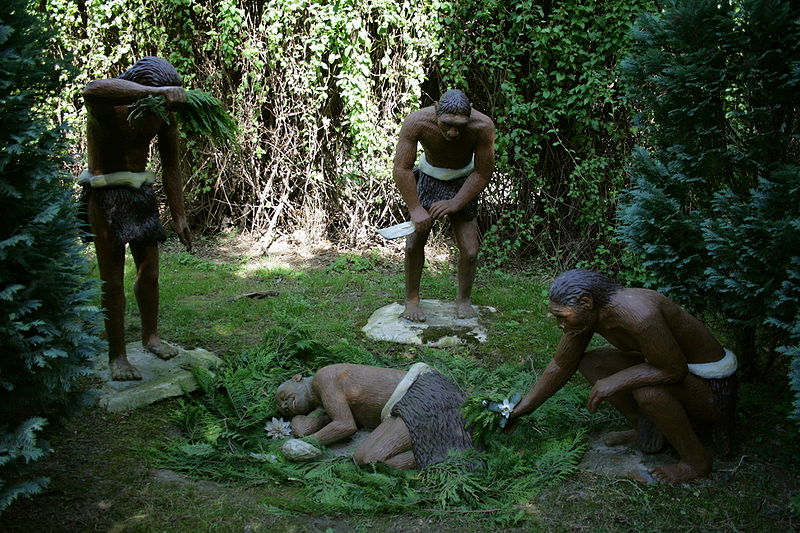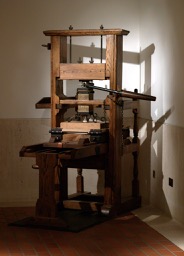As children, most of us picture Neanderthals as the archetypal caveman even though Neanderthals are the most recent archaic humans to Homo sapiens. First emerging between 300,000 and 100,000 years ago, Neanderthals lived in a landscape filled with limestone caves. Because limestone is an excellent preserver of bones, we know more about Neanderthals than any other archaic human group.1 Archaeologists have been studying Neanderthal sites since the mid-1850s. We know how they lived, what they ate, how they hunted, the tools they used and how those tools changed over time, and what they wore.2 We even know that they buried their dead. Or did they? Archaeologists have been studying this possibility for over one-hundred years and still cannot seem to agree on the matter.
The controversy over Neanderthal burial of the dead began with the discovery of a body in a cave in La Chapelle-aux-Saints in southwest France, originally found in 1908. It was the first intact body found buried in the limestone caves frequently used by the Neanderthals as homes. A debate quickly arose among archaeologists to determine if the body had been buried or if it was simply an ancient body dump. A private team was hired to reexamine the evidence from the original excavation and they found the burial to be authentic because the body was not in a natural formation but had, in fact, been placed in a grave dug by human tools.3 Re-excavation of the cave revealed more Neanderthal bones and teeth, tools, and animal remains. Scientists were able to conclude that since the animal bones found in the cave showed signs of scavenger activity and the buried body did not, the body must have been buried quickly after death to have prevented normal scavenger activity. They also found no weathering on the Neanderthal bones from the burial site, but they did find weathering on the animal bones found loose in the cave, further implying that the body had been buried soon after death.4
The Shanidar Cave in the Kurdistan area of northern Iraq is a Neanderthal cave where eight adults and two infants were found buried in a grouping of graves. The Shanidar skeletons and grave sites have been well studied by archaeologists who have made several assumptions about Neanderthals based on the findings. One of the graves contained pollen from flowers that could only have come from a mountain range near the Shanidar Cave. Archaeologists believe that this is evidence that the body was either buried with flowers or the flowers were placed upon the grave after the burial, much like modern humans do at funerals. Another one of the Shanidar skeletons shows extensive injuries that had healed before death. This demonstrates that not only did the Neanderthal have some basic first aid skills, but they took care of their sick and injured. Archaeologists claim that this is suggestive of the Neanderthals possessing a complex social society.5
Excavations at the La Ferrassie location began over one-hundred years ago and have revealed seven Neanderthal skeletons, of which five are children. Examination of the burial sites at La Ferrassie demonstrate that all of the bodies were deliberately buried.6 Archaeologists have also revealed that the bodies were all found in what appears to be a cemetery type layout, with all the bodies oriented with their head facing east and feet facing west. The adult male, the most complete Neanderthal skeleton to date, shows that he was buried in a shallow grave in a fetal position with three rocks placed on his head. He also had flint tools and pieces of animal bones in his grave. The adult female was also in a fetal position, possibly tied with ropes, and placed in a small grave. The children were all buried with scrapers and pointed tools.7

At the Le Moustier site, several graves have been found, all of them shallow with the body in a fetal position. One particular grave contains the body of a young Neanderthal boy buried with flints under his head as if a pillow, an ax in his hand, an ox skull near his head, and cattle bones spread around him. What made this unusual was the finding that some of the cattle bones had been charred. Scientists have wondered if the charred bones were a sign of a funeral feast or provisions for the afterlife, both of which indicate that Neanderthals had a more complex social system than originally believed.8

Other burials in the area occupied by Neanderthals show similar attributes. In Uzbekistan, at Teshik Tash, a young Neanderthal boy was found buried with forty goat horns circling his body, points driven into the ground. At Saint-Cesaire, a Neanderthal adult was found buried with stone tools, some in his hands as if being used. A burial in Spy shows evidence of a fire on the top of the grave site, although archaeologists are not sure the intent of the fire. Mounting evidence shows that Neanderthals buried their dead much like other ancient cultures.9 Nothing demonstrates this more than the finding at Des-Cubierta Cave.
The Des-Cubierta Cave, north of Madrid, holds what archaeologists say is the first firm evidence of Neanderthal funerals. A series of small fires has been discovered surrounding a burial site of a young child known as Lozoya Child. All that has been found of the toddler is a jaw bone and six teeth that date back approximately 38,000 to 42,000 years ago. The child was buried with stone tools as well. Archaeologists found in each fire a horn or antler from local herbivores, aurochs, bison, and red deer to be exact. There was also a rhinoceros skull nearby.10
When examining the evidence gathered from the Lozoya Child and found at Des-Cubierta Cave, anthropologists have come to the conclusion that the cave was used as a specific place to mourn and remember the dead. They argue that the position of the bones and the stone tools found with the body, indicate it was not a random placement nor that cave was a dwelling and the tools just happened to be where the body landed. Anthropologists believe the layout of the cave, the location of the approximately 30 fires with horns or antlers, and the placement of the skull, all have the appearance of a place where rituals took place, or at the very least the cave held symbolic significance to the Neanderthal in the area.11 Archaeologists had found some caves with bones and antlers in Israel and Syria, but nothing as elaborate as the cave at Des-Cubierta.
A good archaeologist knows that when excavating old sites, it is always difficult to determine if the items found in a grave were put there on purpose or if they fell in by accident. It is even possible that the items just happened to be laying on the ground when the body was put there. Some archaeologists argue that Neanderthal burials and funerals are just a modern interpretation of what happened, a desire to place our belief system on an archaic human.12 In the case of the fire at the Spy burial, it could just simply be a fire that was built on top of a long forgotten grave. The pollen at the Shanidar grave could have been there long before the body was placed there. Or it is possible it was from flowers placed there to mask the odor of decaying bodies?
An example of this can be found at Rod de Marsal where a complete skeleton of a Neanderthal child was excavated in 1961. This burial was long used to support the argument in favor of Neanderthals burying their dead; however, modern archaeology tools and techniques have changed that idea. It is now widely accepted that the child simply fell through a crevice into a natural pit from above along with the tools found near him.13 Some archaeologists would argue that if we are wrong about one burial, how many others have we gotten wrong over the last century?
The reason so much emphasis is placed on Neanderthal burials is not so much to determine if they buried their dead or even how they buried them. Today scientists commonly accept that Neanderthals did bury their dead otherwise the number of graves would be much smaller.14 If Neanderthals simply wanted to dispose of the dead away from the campsite, they could have just carried them off a distance or thrown them into a ravine, problem solved. But we know that they buried their dead; that is not any longer the question to ask. What does matter is why they buried them.15

We know that Neanderthals lived in social groupings and they decorated their bodies and used complex tools that changed over time. All of this is proof that Neanderthals had social and cultural traditions.16 Burials are considered a key feature of human behavior, but funerals are considered a feature of the belief in an afterlife. If Neanderthals actually had funerals for their people, then there is an assumption that they did this for one of two reasons: to remember their departed loved one as we do today, or to leave the body with the items it needed to pass into the afterlife. In either case, a funeral is a symbolic act and if Neanderthals were holding funerals, they are more complex and have a higher society than scientists had believed.17
- Britannica School, January 2015, s.v. “Neanderthal,” by Erik Trinkaus and Russel Howard Tuttle. ↵
- Britannica School, January 2015, s.v. “Neanderthal,” by Erik Trinkaus and Russel Howard Tuttle. ↵
- Zach Zorich, “Did Neanderthals Bury Their Dead?” Archaeology 67, no. 2 (March/April 2014): 19. ↵
- Kate Wong, “Ancient Burial,” Scientific American 310, no. 3 (March 2014): 19. ↵
- Owen Edwards, “The Skeletons of Shanidar Cave,” Smithsonian Magazine 38, no. 6 (March 2010): 18. ↵
- Michael Balter, “Did Neanderthals Truly Bury Their Dead?” Science 337, no. 6101, (September 2012): 1443-1444. ↵
- Paul Jordan, Neanderthal (United Kingdom: Sutton, 1999), 102-106. ↵
- Paul Jordan, Neanderthal (United Kingdom: Sutton, 1999), 100. ↵
- Paul Jordan, Neanderthal (United Kingdom: Sutton, 1999), 97-102. ↵
- Richard Gray, “First Known Neanderthal Burial Rituals,” New Scientist 232, no. 3093, (October 2016): 14. ↵
- Richard Gray, “First Known Neanderthal Burial Rituals,” New Scientist 232, no. 3093, (October 2016): 14. ↵
- Michael Balter, “Did Neanderthals Truly Bury Their Dead?” Science 337, no. 6101, (September 2012): 1443-1444. ↵
- Michael Balter, “Did Neanderthals Truly Bury Their Dead?” Science 337, no. 6101, (September 2012): 1443-1444. ↵
- Michael Balter, “Did Neanderthals Truly Bury Their Dead?” Science 337, no. 6101, (September 2012): 1443-1444. ↵
- Michael Balter, “Did Neanderthals Truly Bury Their Dead?” Science 337, no. 6101, (September 2012): 1443-1444. ↵
- Paul Jordan, Neanderthal (United Kingdom: Sutton, 1999), 100. ↵
- Michael Balter, “Did Neanderthals Truly Bury Their Dead?” Science 337, no. 6101, (September 2012): 1443-1444. ↵



36 comments
Samantha Ruvalcaba
What an interesting topic. I’ve never quite separated the terms “caveman” and “neanderthal”. I always assumed the two were synonymous. I really enjoyed the flow of this article and how it explores the different regions in which the Neanderthals existed, influenced, and drew from. All the while sticking to the thematic question of the article: how did Neanderthals do their burials? Very interesting read.
Mariah Cavanaugh
It is fascinating to consider that ancient Neanderthals engaged in practices not that dissimilar from our own. Throughout time it seems there are ties that bind us all together. The mourning process, honoring our dead, and perhaps even preparing them for an after life it that is indeed what the Neanderthals were doing. It seems likely given that they buried their deceased with tools as if preparing them for what came next.
Brianna Nevarez
I found this reading enthralling. Last time I had read anything regarding Neanderthals was in the 6th grade, my knowledge of them was extremely limited. I always questioned if they had a language which they used to communicate with each other and present sophisticated ideas. I wondered if they had rituals and ceremonies to celebrate weddings or birth dates. I now know they had respect for life and celebrated it by burying their dead, they honored them by providing them a resting place. I am appalled that Neanderthals did this for I regarded them as unintelligent as they are portrayed on television or articles. I can make the inference that they had a language, it might have been simple, to communicate their emotions and thoughts.
Dalton Moy
This was a very interesting read. I had not really thought about the cultural actions of Neanderthals, or as many call, Cavemen. After reading this article I am seeing why this could be a topic of interest. It could be an explanation of why we perform different cultural actions today. This may also help us understand the most basic instincts of a human, without the influence of a civilized culture. I hadn’t heard or thought of a Neanderthal grave before, so it is cool to think about how our ancestors were much more advanced than we usually give them credit for.
Katherine Wolf
I was always under the impression that Neanderthals were these hairy, short, ugly, bumbling creatures with limited intelligence. This article has really opened my eyes to see that these ancestors were a lot more complex than that. I think that it is kind of beautiful and comforting to see that since the beginning, humans have had a reverence for their dead and wanted to try to connect to them or remember them in some way. The Neanderthals definitely deserve to have many of those stereotypes of them being “archetypal caveman” corrected.
Caden Floyd
I had never really thought about the neanderthals in the way I am now after reading this article. They deserve a lot of credit in my opinion for getting as far as they did and prospering due to their lack of knowledge and anything we have today that they didn’t. They weren’t just big walking dummies who would beat anything they saw to death with a club. They are more educated than that and had morals and compassion. This was a very well written article and really opened my eyes.
Kristy Feather
I feel as if most of the time we don’t give enough credit to the Neanderthals. Even though humans are probably significantly more intelligent, Neanderthals are still creatures of intelligence and emotions. They were able to survive on the earth and eventually evolve into what we are today, which shows some level of superiority. If they could eventually evolve into today’s society the they must also have been able to obtain some feeling of emotions meaning they would probably have been able to have remorse for dead bodies.
Noah Bolhuis
I had never put any thought of how and why ancient neanderthals buried their dead. This article was very enlightening, and showed that these ancient people weren’t as primitive and brainless as I had thought. The placing of flowers in the grave of deceased loved ones was an apparent tradition that they did tens of thousands of years ago, so it is crazy to think that that tradition has carried through to today. Also, the article says they had basic first aid knowledge, so they really aren’t that distant.
Constancia Tijerina
This is really an amazing article! When someone, like myself, I believed them to be such as idiots who don’t know what the color red is. This article truly opened my mind to who the Neanderthals really were. These people were people who have somewhat of a system, they showed signs of morals and there were signs of ceremony. This article intrigued me of how this people would put their loved ones in a sentimental and thoughtful ceremony instead of just letting them rot right next to them. Overall, I loved this article and was a very interesting read!
Thomas Fraire
Goodness, your article was exceptionally intriguing! I generally picture Neanderthals as moderate and more idiotic, particularly with how they delineate them in kid’s shows. Nonetheless, they’re a great deal more quick-witted than I thought! I thought that it was astonishing at how they had their own particular internment procedures and ceremonies instead of simply tossing their loved ones aside to deteriorate. They really appear to be more taught than how we depict them and they merit more credit.